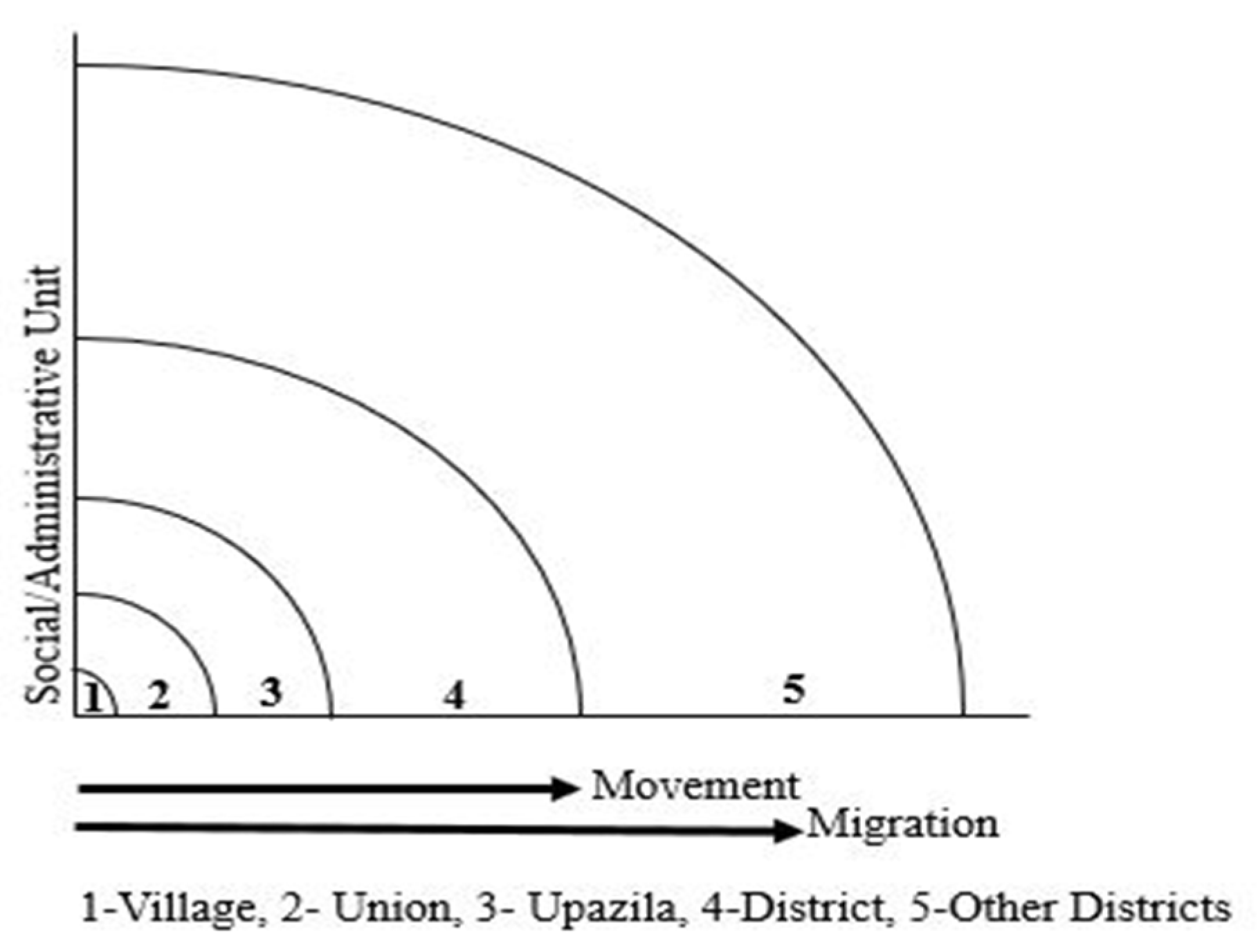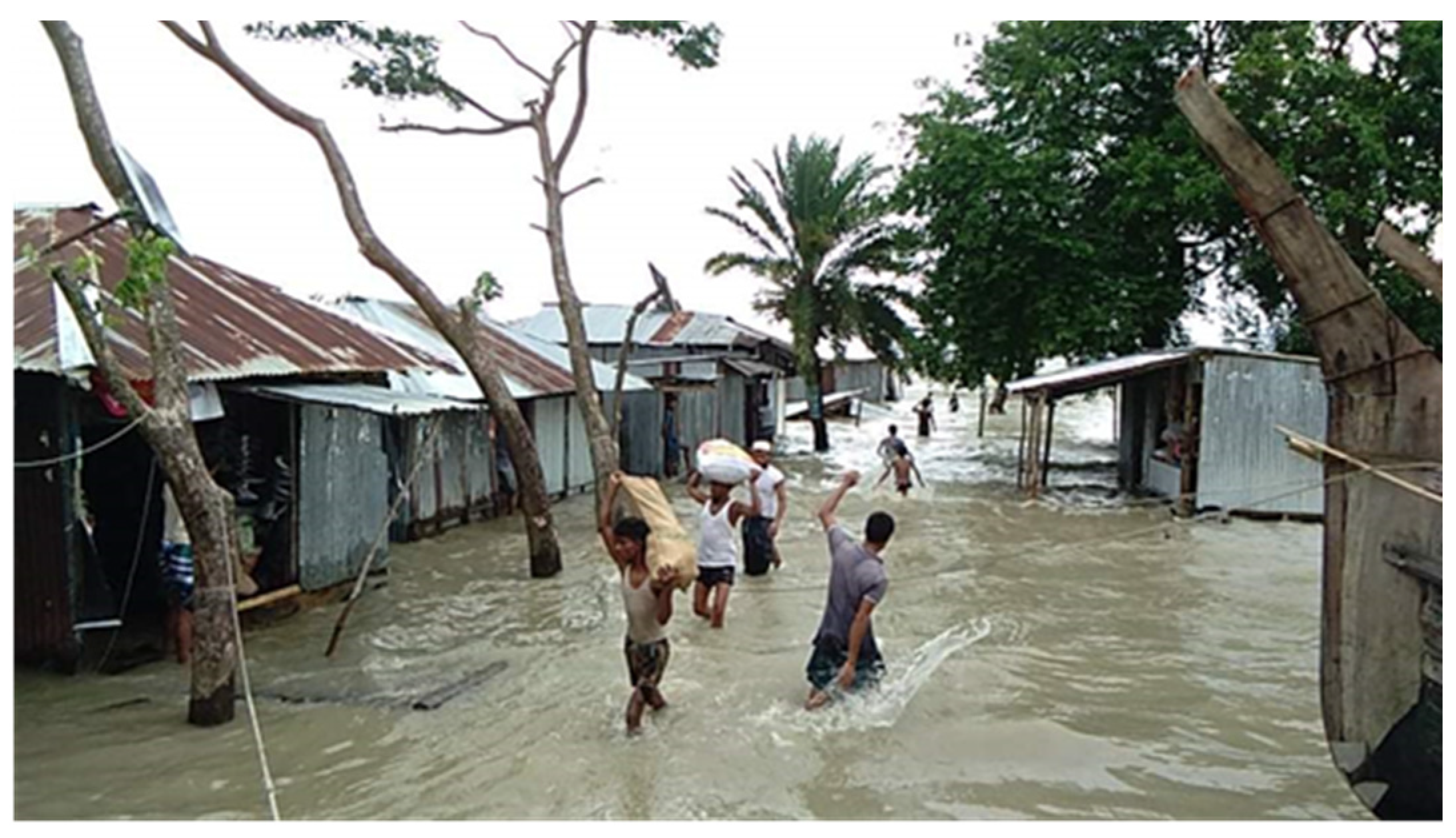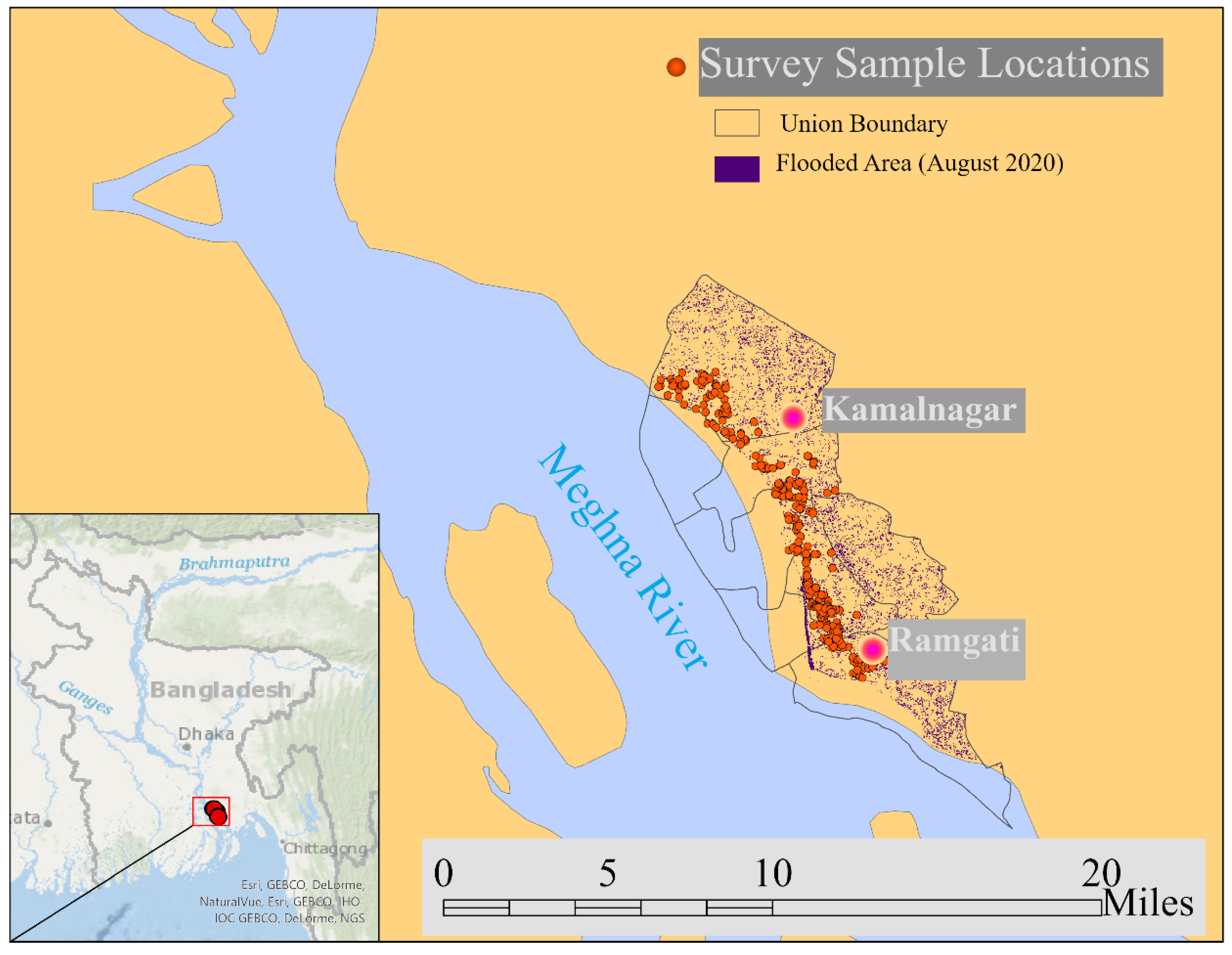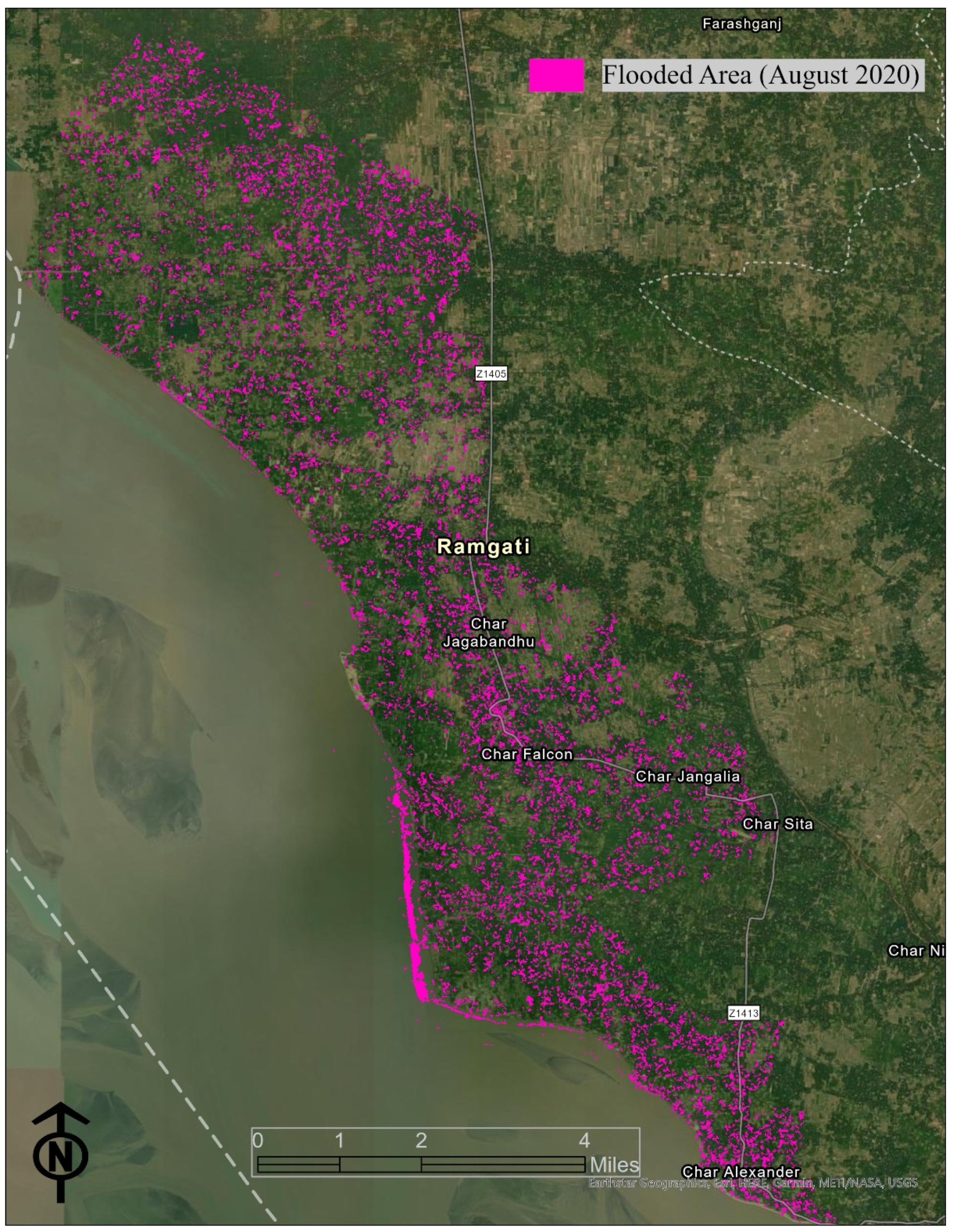Household Migration and Intentions for Future Migration in the Climate Change Vulnerable Lower Meghna Estuary of Coastal Bangladesh
Abstract
:1. Introduction
2. Issues Related to Migration and Non-Migration in Bangladesh: A Review
2.1. Migration Definitions
2.2. Migration and Non-Migration
3. The August 2020 Flash Flood Event
4. Materials and Methods
4.1. Study Area and Sources of Data
4.2. Statistical Technique
5. Results
6. Discussion
7. Conclusions
Author Contributions
Funding
Institutional Review Board Statement
Informed Consent Statement
Data Availability Statement
Conflicts of Interest
References
- Myers, N. Environmental refugees: An emergent security issue. In Proceedings of the 13th Economic Forum, Prague, Czech Republic, 23–27 May 2005. [Google Scholar]
- Myers, N. Environmental refugees: A growing phenomenon of the 21st century. Philos. Trans. R. Soc. Lond. Ser. B Biol. Sci. 2002, 357, 609–613. [Google Scholar] [CrossRef] [PubMed]
- Piguet, E.; Pécoud, A.; De Guchteneire, P. Migration and climate change: An overview. Refug. Surv. Q. 2011, 30, 1–23. [Google Scholar] [CrossRef] [Green Version]
- Piguet, E. From “primitive migration” to “climate refugees”: The curious fate of the natural environment in migration studies. Ann. Assoc. Am. Geogr. 2013, 103, 148–162. [Google Scholar] [CrossRef]
- IPCC. Climate Change 2007—Migration of Climate Change. In Contribution of Working Group III to the Fourth Assessment Report of the IPCC; Intergovernmental Panel on Climate Change: Cambridge, UK, 2007. [Google Scholar]
- Mortreux, C.; Barnett, J. Climate change, migration and adaptation in Funafuti, Tuvalu. Glob. Environ. Change 2009, 19, 105–112. [Google Scholar] [CrossRef]
- Leckie, S. Climate-related disasters and displacement: Homes for lost homes, lands for lost lands. In Population Dynamics and Climate Change; Guzman, J.M., Martine, G., McGranahan, G., Schensul, D., Tacoli, C., Eds.; UNFPA and IIED: New York, NY, USA, 2009; pp. 119–132. [Google Scholar]
- Tacoli, C. Crisis or adaptation? Migration and climate change in a context of high mobility. Environ. Urban. 2009, 21, 513–525. [Google Scholar] [CrossRef] [Green Version]
- Biermann, F.; Boas, I. Preparing for a warmer world: Towards a global governance system to protect climate refugees. Glob. Environ. Politics 2010, 10, 60–88. [Google Scholar] [CrossRef]
- Biermann, F.; Boas, I. Protecting climate refugees: The case for a global protocol. Environ. Sci. Policy Sustain. Dev. 2008, 50, 8–17. [Google Scholar] [CrossRef]
- Albo, A.; JL, O.; Alscher, S. Foresight. In Migration and Global Environmental Change: Final Report; The Government Office for Science: London, UK, 2011. [Google Scholar]
- Gemenne, F.; Blocher, J. How can migration serve adaptation to climate change? Challenges to fleshing out a policy ideal. Geogr. J. 2017, 183, 336–347. [Google Scholar] [CrossRef] [Green Version]
- Adger, N.; Adams, H. Migration as an adaptation strategy to environmental change. World Sci. Rep. 2013, 261–264. [Google Scholar] [CrossRef]
- McLeman, R.; Smit, B. Migration as an adaptation to climate change. Clim. Change 2006, 76, 31–53. [Google Scholar] [CrossRef]
- Chaturvedi, S.; Doyle, T. Geopolitics of fear and the emergence of ‘climate refugees’: Imaginative geographies of climate change and displacements in Bangladesh. J. Indian Ocean. Reg. 2010, 6, 206–222. [Google Scholar] [CrossRef]
- Brammer, H. Climate Change, Sea-Level Rise and Development in Bangladesh; The University Press: Dhaka, Bangladesh, 2014. [Google Scholar]
- Rashid, M.M. Migration to big cities from coastal villages of Bangladesh: An empirical analysis. Glob. J. Hum. Soc. Sci. 2013, 13, 28–36. [Google Scholar]
- Paul, B.K.; Rashid, H. Climatic hazards in coastal Bangladesh. Sci. Direct 2017, 153–182. [Google Scholar] [CrossRef]
- Bernzen, A.; Jenkins, J.C.; Braun, B. Climate change-induced migration in coastal Bangladesh? A critical assessment of migration drivers in rural households under economic and environmental stress. Geosciences 2019, 9, 51. [Google Scholar] [CrossRef] [Green Version]
- Dasgupta, S.; Akhter Kamal, F.; Huque Khan, Z.; Choudhury, S.; Nishat, A. River salinity and climate change: Evidence from coastal Bangladesh. In World Scientific Reference on Asia and the World Economy; World Scientific: Singapore, 2015; pp. 205–242. [Google Scholar] [CrossRef] [Green Version]
- IPCC. Technical summary. In Climate Change 2014: Impacts, Adaptation, and Vulnerability. Part A: Global and Sectoral Aspects. Contribution of Working Group II to the Fifth Assessment Report of the Intergovernmental Panel on Climate Change; Field, C.B., Barros, V.R., Mach, K.J., Van Aalist, M.D.M.M., Adger, W., Arent, D.J., Barnett, J., Betts, R., Bilir, T.E., Eds.; Intergovernmental Panel on Climate Change: Cambridge, UK, 2014. [Google Scholar]
- Walsham, M. Assessing the Evidence: Environment, Climate Change and Migration in Bangladesh; International Organization for Migration (IOM), Regional Office for South Asia: Dhaka, Bangladesh, 2010. [Google Scholar]
- Ahsan, R.; Kellett, J.; Karuppannan, S. Climate Induced Migration: Lessons from Bangladesh; Common Ground Publishing: Champaign, IL, USA, 2014. [Google Scholar]
- Chen, J.; Mueller, V. Coastal climate change, soil salinity and human migration in Bangladesh. Nat. Clim. Change 2018, 8, 981–985. [Google Scholar] [CrossRef]
- Sultana, P.; Thompson, P.M.; Wesselink, A. Coping and resilience in riverine Bangladesh. Environ. Hazards 2020, 19, 70–89. [Google Scholar] [CrossRef]
- Swain, A. Displacing the conflict: Environmental destruction in Bangladesh and ethnic conflict in India. J. Peace Res. 1996, 33, 189–204. [Google Scholar] [CrossRef]
- Azam, M.; Falk, G.C. Governance of climate induced migration in the coastal regions of Bangladesh: New transformation required. In Proceedings of the Earth System Governance Tokyo Conference, Tokyo, Japan, 28–31 January 2013. [Google Scholar]
- Chen, J.J.; Mueller, V.; Jia, Y.; Tseng, S.K.-H. Validating migration responses to flooding using satellite and vital registration data. Am. Econ. Rev. 2017, 107, 441–445. [Google Scholar] [CrossRef] [Green Version]
- Paul, B.K.; Rahman, M.K.; Crawford, T.; Curtis, S.; Miah, M.G.; Islam, M.R.; Islam, M.S. Explaining mobility using the Community Capital Framework and Place Attachment concepts: A case study of riverbank erosion in the Lower Meghna Estuary, Bangladesh. Appl. Geogr. 2020, 125, 102199. [Google Scholar] [CrossRef]
- Gray, C.L.; Mueller, V. Natural disasters and population mobility in Bangladesh. Proc. Natl. Acad. Sci. USA 2012, 109, 6000–6005. [Google Scholar] [CrossRef] [Green Version]
- Amrith, S.S. Crossing the Bay of Bengal; Harvard University Press: Cambridge, MA, USA, 2013. [Google Scholar]
- Call, M.A.; Gray, C.; Yunus, M.; Emch, M. Disruption, not displacement: Environmental variability and temporary migration in Bangladesh. Glob. Environ. Change 2017, 46, 157–165. [Google Scholar] [CrossRef] [PubMed] [Green Version]
- Bell, A.; Wrathall, D.; Mueller, V.; Chen, J.; Oppenheimer, M.; Hauer, M.; Adams, H.; Kulp, S.; Clark, P.; Fussell, E.; et al. Migration towards Bangladesh coastlines projected to increase with sea-level rise through 2100. Environ. Res. Lett. 2021, 16, 024045. [Google Scholar] [CrossRef]
- Adger, W.N. Vulnerability. Glob. Environ. Change 2006, 16, 268–281. [Google Scholar] [CrossRef]
- Castles, S.; Miller, M. The Age of Migration: International Population Movements in the Modern World; The Guilford Press: New York, NY, USA; London, UK, 2009. [Google Scholar]
- Black, R.; Adger, W.N.; Arnell, N.W.; Dercon, S.; Geddes, A.; Thomas, D. The effect of environmental change on human migration. Glob. Environ. Change 2011, 21, S3–S11. [Google Scholar] [CrossRef]
- McLeman, R. Thresholds in climate migration. Popul. Environ. 2018, 39, 319–338. [Google Scholar] [CrossRef]
- Olshansky, R.B. Planning after hurricane Katrina. J. Am. Plan. Assoc. 2006, 72, 147–153. [Google Scholar] [CrossRef]
- Birkmann, J.; Buckle, P.; Jaeger, J.; Pelling, M.; Setiadi, N.; Garschagen, M.; Fernando, N.; Kropp, J. Extreme events and disasters: A window of opportunity for change? Analysis of organizational, institutional and political changes, formal and informal responses after mega-disasters. Nat. Hazards 2010, 55, 637–655. [Google Scholar] [CrossRef]
- Weeks, J.R. Population: An Introduction to Concepts and Issues; Cengage Learning: Boston, MA, USA, 2020. [Google Scholar]
- Kartiki, K. Development, Climate change and migration: A case study from rural Bangladesh. Gend. Dev. 2011, 19, 23–38. [Google Scholar] [CrossRef]
- Penning-Rowsell, E.C.; Sultana, P.; Thompson, P.M. The ‘last resort’? Population movement in response to climate-related hazards in Bangladesh. Environ. Sci. Policy 2013, 27, S44–S59. [Google Scholar] [CrossRef]
- Martin, M.; Billah, M.; Siddiqui, T.; Abrar, C.; Black, R.; Kniveton, D. Climate-related migration in rural Bangladesh: A behavioural model. Popul. Environ. 2014, 36, 85–110. [Google Scholar] [CrossRef]
- Etzold, B.; Mallick, B. Moving beyond the focus on environmental migration towards recognizing the normality of translocal lives: Insights from Bangladesh. In Migration, Risk Management and Climate Change: Evidence and Policy Responses; Springer: Berlin/Heidelberg, Germany, 2016; pp. 105–128. [Google Scholar] [CrossRef]
- Stojanov, R.; Kelman, I.; Ullah, A.; Duží, B.; Procházka, D.; Blahůtová, K.K. Local expert perceptions of migration as a climate change adaptation in Bangladesh. Sustainability 2016, 8, 1223. [Google Scholar] [CrossRef] [Green Version]
- Assaduzzaman, M.; Filatova, T.; Coenen, F.; Lovett, J. Freedom of choice to migrate: Adaptation to climate change in Bangladesh. Int. J. Sustain. Dev. World Ecol. 2020, 27, 652–661. [Google Scholar] [CrossRef]
- Mallick, A.; Mallick, B. Staying despite riverbank erosion: Evidence of coastal Bangladesh. SN Soc. Sci. 2021, 1, 155. [Google Scholar] [CrossRef]
- Lu, X.; Wrathall, D.J.; Sundsøy, P.R.; Nadiruzzaman, M.; Wetter, E.; Iqbal, A.; Qureshi, T.; Tatem, A.; Canright, G.; Engø-Monsen, K. Unveiling hidden migration and mobility patterns in climate stressed regions: A longitudinal study of six million anonymous mobile phone users in Bangladesh. Glob. Environ. Change 2016, 38, 1–7. [Google Scholar] [CrossRef] [Green Version]
- Mallick, B. The nexus between socio-ecological system, livelihood resilience, and migration decisions: Empirical evidence from Bangladesh. Sustainability 2019, 11, 3332. [Google Scholar] [CrossRef] [Green Version]
- Carrico, A.R.; Donato, K. Environment, Extreme weather and migration: Evidence from Bangladesh. Popul. Environ. 2019, 41, 1–31. [Google Scholar] [CrossRef]
- BBS. Population and Housing Census 2011: Preliminary Result; Ministry of Planning: Dhaka, Bangladesh, 2012.
- BBS. Population Distribution and Internal Migration in Bangladesh; Ministry of Planning: Dhaka, Bangladesh, 2015.
- Best, K.B.; Gilligan, J.M.; Baroud, H.; Carrico, A.R.; Donato, K.M.; Ackerly, B.A.; Mallick, B. Random forest analysis of two household surveys can identify important predictors of migration in Bangladesh. J. Comput. Soc. Sci. 2021, 4, 77–100. [Google Scholar] [CrossRef]
- Mallick, B.; Sultana, Z.; Bennett, C.M. How do sustainable livelihoods influence environmental (non-) migration aspirations? Appl. Geogr. 2020, 124, 102328. [Google Scholar] [CrossRef]
- Mallick, B.; Rogers, K.G.; Sultana, Z. In harm’s way: Non-migration decisions of people at risk of slow-onset coastal hazards in Bangladesh. Ambio 2022, 51, 114–134. [Google Scholar] [CrossRef]
- Mallick, B.; Schanze, J. Trapped or voluntary? Non-migration despite climate risks. Sustainability 2020, 12, 4718. [Google Scholar] [CrossRef]
- Schewel, K. Understanding immobility: Moving beyond the mobility bias in migration studies. Int. Migr. Rev. 2020, 54, 328–355. [Google Scholar] [CrossRef]
- Black, R.; Arnell, N.W.; Adger, W.N.; Thomas, D.; Geddes, A. Migration, immobility and displacement outcomes following extreme events. Environ. Sci. Policy 2013, 27, S32–S43. [Google Scholar] [CrossRef]
- Black, R.; Collyer, M. “Trapped” Populations: Limits on Mobility at Times of Crisis; Routledge: London, UK, 2014. [Google Scholar]
- Adams, H. Why populations persist: Mobility, place attachment and climate change. Popul. Environ. 2016, 37, 429–448. [Google Scholar] [CrossRef]
- The White House. Report on the Impact of Climate Change on Migration; Global Environment OutlookGEOG4; UNEP (United Nations Environment Programme): Washington, DC, USA, 2021. [Google Scholar]
- Ayeb-Karlsson, S.; Smith, C.D.; Kniveton, D. A discursive review of the textual use of ‘trapped’in environmental migration studies: The conceptual birth and troubled teenage years of trapped populations. Ambio 2018, 47, 557–573. [Google Scholar] [CrossRef] [PubMed] [Green Version]
- Mallick, B.; Vogt, J. Cyclone, coastal society and migration: Empirical evidence from Bangladesh. Dev. Plan. Rev. 2012, 34, 217–241. [Google Scholar] [CrossRef]
- Haney, T.J. Move out or dig in? Risk awareness and mobility plans in disaster-affected communities. J. Contingencies Crisis Manag. 2019, 27, 224–236. [Google Scholar] [CrossRef] [Green Version]
- Logan, J.R.; Issar, S.; Xu, Z. Trapped in place? Segmented resilience to hurricanes in the Gulf Coast, 1970–2005. Demography 2016, 53, 1511–1534. [Google Scholar] [CrossRef] [Green Version]
- Paul, B.K.; Bhuiyan, R.H. Urban earthquake hazard: Perceived seismic risk and preparedness in Dhaka City, Bangladesh. Disasters 2010, 34, 337–359. [Google Scholar] [CrossRef]
- Rahman, M.K.; Paul, B.K.; Curtis, A.; Schmidlin, T.W. Linking coastal disasters and migration: A case study of Kutubdia Island, Bangladesh. Prof. Geogr. 2015, 67, 218–228. [Google Scholar] [CrossRef]
- Shampa, A.H.; Rahman, M.A.; Hossain, D.; Azad, A.A.; Mita, S. Evaluating Future Threats of Climate Change on Riverine and Coastal Chars. In Living on the Edge; Zaman, M., Alam, M., Eds.; Springer: Gewerbestrasse, Switzerland, 2021; pp. 185–211. [Google Scholar]
- Rasid, H.; Paul, B. Climate Change in Bangladesh: Confronting Impending Disasters; Lexington Books: New York, NY, USA, 2013. [Google Scholar]
- Bardsley, D.K.; Hugo, G.J. Migration and climate change: Examining thresholds of change to guide effective adaptation decision-making. Popul. Environ. 2010, 32, 238–262. [Google Scholar] [CrossRef]
- Berlemann, M.; Tran, T.X. Climate-related hazards and internal migration empirical evidence for rural Vietnam. Econ. Disasters Clim. Change 2020, 4, 385–409. [Google Scholar] [CrossRef] [Green Version]
- Berlemann, M.; Tran, T.X.J. Tropical Storms and Temporary Migration in Vietnam. Popul. Dev. Rev. 2021, 47, 1107–1142. [Google Scholar] [CrossRef]
- Kelman, I.; Orlowska, J.; Upadhyay, H.; Stojanov, R.; Webersik, C.; Simonelli, A.C.; Procházka, D.; Němec, D. Does climate change influence people’s migration decisions in Maldives? Clim. Change 2019, 153, 285–299. [Google Scholar] [CrossRef] [Green Version]
- Khatun, H.; Kabir, M.H.; Nahar, L. Women in chars: Challenges and social development. In Living on the Edge; Zaman, M., Alam, M., Eds.; Springer: Gewerbestrasse, Switzerland, 2021; pp. 302–322. [Google Scholar]
- Zaman, M.J. The displaced poor and resettlement policies in Bangladesh. Disasters 1991, 15, 117–125. [Google Scholar] [CrossRef]
- Paul, B.K.; Ramekar, A. Internal migration in Bangladesh: A comparative analysis of coastal, environmentally challenged, and other districts. In Routledge Handbook of Environmental Displacement and Migration; Gemenne, F., McLeman, R., Eds.; Routledge: London, UK, 2018; pp. 225–237. [Google Scholar]
- Ferdous, M.R.; Wesselink, A.; Brandimarte, L.; Slager, K.; Zwarteveen, M.; Di Baldassarre, G.J. The costs of living with floods in the Jamuna floodplain in Bangladesh. Water 2019, 11, 1238. [Google Scholar] [CrossRef] [Green Version]
- Stark, O.; Bloom, D.E. The new economics of labor migration. Am. Econ. Rev. 1985, 75, 173–178. [Google Scholar]
- Jónsson, G. Non-migrant, sedentary, immobile, or “left behind”? Reflections on the absence of migration. In Spaces in Movement. New Perspectives on Migration in African Settings; Abdalla, E.B.M., Dias Barros, D., Berthet, M., Eds.; Rüdiger Köppe Verlag: Cologne, Germany, 2014; pp. 145–164. [Google Scholar]




| Name | Administrative Hierarchy | Number | Characteristics |
|---|---|---|---|
| Village | Smallest territorial and social unit | 68,038 | Average households size: 232 |
| Union | Lowest tier of administration | 4571 | Comprising of 15–30 villages |
| Upazila | Third lowest tier of administration | 495 | Comprising of 8–15 unions Population ranges between 0.05 and 1.5 million Area ranges between 220 and 1092 sq. miles (572–2829 sq. km) |
| District | Second lowest tier of administration | 44 | Comprising of 8–20 upazilas Average population 2.6 million Average area: 859 sq. miles (2306 sq. km) |
| Source | Spatial Scale | Temporal Scale | Remarks |
|---|---|---|---|
| Bernzen et al. (2019) [19] | Within home union or outside the union | ≤6 months for temporary migration and >6 months for permanent migration | |
| Best et al. (2020) [53] | Within own village | Not specified | Only mentioned movement type and drivers of migration |
| Call et al. (2017) [32] | Outside of the study area (upazila) | More >1 month for temporary migration | Only considered temporary migration irrespective of age |
| Carrico and Donato (2019) [50] | Outside own upazila | ≥3 months | - |
| Chen and Mueller (2018) [24] | Not specified | Between one and 23 months | - |
| Gray and Mueller (2012) [30] | Local mobility within the district | Not specified | They provided two types of mobility, no mention of migration |
| Long-distance mobility outside the home district | Not specified | ||
| Mallick et al. (2020) [54] | Outside own village | Not specified | They mentioned movement type and drivers of migration |
| Rashid (2013) [17] | Not specified for traditional migration definition | Not specified | He provided two definitions of migration |
| Outside own village for applied migration definition | Not specified |
| Indicator | Number | Percentage |
|---|---|---|
| Primary Occupation (N = 293) | ||
| Farmers | 83 | 28.33 |
| Fishing | 83 | 28.33 |
| Both Farmers and Fishers | 23 | 7.85 |
| Service Holders | 40 | 13.65 |
| Small Businesses | 26 | 8.87 |
| Laborers | 18 | 6.14 |
| Others, including Home Makers | 20 | 6.83 |
| Agricultural Land Owned (in decimal) (N = 310) | ||
| Landless | 190 | 61.29 |
| Under 100 | 81 | 26.13 |
| ≥100 | 39 | 12.58 |
| Annual Household Income (in Takas) (N = 310) | ||
| <100,000 | 199 | 64.19 |
| 100,000–250,000 | 105 | 33.87 |
| >250,000 | 6 | 1.94 |
| Educational Level (Years of Schooling) (N = 310) | ||
| Illiterate | 80 | 25.81 |
| 1–5 | 214 | 69.35 |
| >5 | 16 | 5.16 |
| Non-Mover | Mover | Total | ||||
|---|---|---|---|---|---|---|
| Current village | In union but not on current village | Other village in current upazila outside current union | Other village but not in current upazila | Other district | ||
| 294 * | 11 | 4 | - | - | 1 | 310 |
| 90 ** | 6 | 38 | 117 | 38 | 21 | 310 |
| Socio-Economic Status | No. of Mover (%) | No. of Non-Mover (%) | Total (%) |
|---|---|---|---|
| Primary Occupation | |||
| Farming, Fishing, and Both * | 121 (59.61) | 68 (75.56) | 189 (64.51) |
| Service Holders | 35 (17.24) | 5 (5.56) | 40 (13.65) |
| Small Businesses | 21 (10.34) | 5 (5.56) | 26 (8.87) |
| Laborers | 10 (4.93) | 8 (8.88) | 18 (6.14) |
| Others | 16 (7.88) | 4 (4.44) | 20 (6.83) |
| Total | 203 (100.00) | 90 (100.00) | 293 (100.00) |
| Agricultural Land Owned | |||
| Landless | 140 (63.64) | 50 (55.56) | 190 (61.29) |
| Under 100 decimal | 59 (26.81) | 22 (24.44) | 81 (26.13) |
| ≤100 decimal | 21 (9.55) | 18 (20.00) | 39 (12.58) |
| Total | 220 (100.00) | 90 (100.00) | 310 (100.00) |
| Annual Household Income | |||
| <100,000 Tk. | 158 (71.82) | 41 (45.56) | 199 (64.19) |
| 100,000–250,000 Tk. | 56 (25.45) | 49 (54.44) | 105 (33.87) |
| >250,000 Tk. | 6 (2.73) | - | 6 (1.94) |
| Total | 220 (100.00) | 90 (100.00) | 310 (100.00) |
| Educational Level | |||
| Illiterate | 48 (21.82) | 32 (35.56) | 80 (25.81) |
| 1–5 Years of Schooling | 158 (71.82) | 56 (62.22) | 214 (69.03) |
| >5 Years of Schooling | 14 (6.36) | 2 (2.22) | 16 (5.16) |
| Total | 220 (100.00) | 90 (100.00) | 310 (100.00) |
Publisher’s Note: MDPI stays neutral with regard to jurisdictional claims in published maps and institutional affiliations. |
© 2022 by the authors. Licensee MDPI, Basel, Switzerland. This article is an open access article distributed under the terms and conditions of the Creative Commons Attribution (CC BY) license (https://creativecommons.org/licenses/by/4.0/).
Share and Cite
Paul, B.K.; Rahman, M.K.; Lu, M.; Crawford, T.W. Household Migration and Intentions for Future Migration in the Climate Change Vulnerable Lower Meghna Estuary of Coastal Bangladesh. Sustainability 2022, 14, 4686. https://doi.org/10.3390/su14084686
Paul BK, Rahman MK, Lu M, Crawford TW. Household Migration and Intentions for Future Migration in the Climate Change Vulnerable Lower Meghna Estuary of Coastal Bangladesh. Sustainability. 2022; 14(8):4686. https://doi.org/10.3390/su14084686
Chicago/Turabian StylePaul, Bimal Kanti, Munshi Khaledur Rahman, Max Lu, and Thomas W. Crawford. 2022. "Household Migration and Intentions for Future Migration in the Climate Change Vulnerable Lower Meghna Estuary of Coastal Bangladesh" Sustainability 14, no. 8: 4686. https://doi.org/10.3390/su14084686
APA StylePaul, B. K., Rahman, M. K., Lu, M., & Crawford, T. W. (2022). Household Migration and Intentions for Future Migration in the Climate Change Vulnerable Lower Meghna Estuary of Coastal Bangladesh. Sustainability, 14(8), 4686. https://doi.org/10.3390/su14084686






